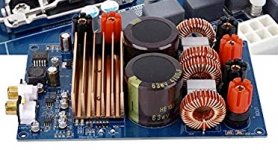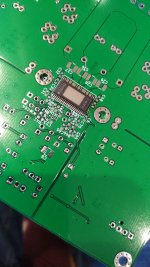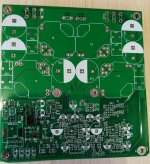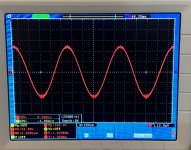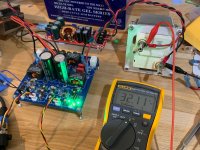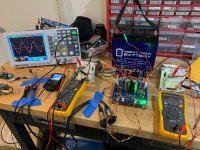I am certainly not the best to answer, but I tried rolling opamps in a Zishan z2. I tried the opa627, like you I found it much too warm. The best by quite a bit was the LME49720HA, the metal one. It ought to be the same as the non-HA, but it didn't care and just sounded better - very liquid, it just sounded right and magical somehow. I also tried the muses02 but the HA was better - I believe the muses was a bit bright, where the HA was a bit warmer but still completely clear. Also tried Burson v5i, came in second place but was much more expensive. The guy I sold it all to came to the same conclusions. So I would consider the HA or just the ne5532, which I believe measure so good it will not be the limiting factor. Just be sure to get genuine ones no matter which.
I would surely try the LME49720HA, but unfortunately I cannot roll at the moment 😉
But then again, I know neither if they will fit your amp or has anything to say for the rca outs (but I think).
Many thanks for this feedback. I already tried the LME49720HA but I prefer the OPA1622. Sounds great to my ears.
So my question would be : anyone tried the SPARKOS LABS SS3602 ?
Hi guys
Well, despite owning a few great sounding Class D power amps already my curiosity took over so I’ve decided to take the plunge and buy a 3e TPA3255. It will be powered by an excellent quality 600W, 47Vdc SMPS from Cresnet on the vendors section.
Hopefully the 3255 is as good as the hype.
Eric
Well, despite owning a few great sounding Class D power amps already my curiosity took over so I’ve decided to take the plunge and buy a 3e TPA3255. It will be powered by an excellent quality 600W, 47Vdc SMPS from Cresnet on the vendors section.
Hopefully the 3255 is as good as the hype.
Eric
Last edited:
3255 is great, but the output conductors on these boards generate a lot of distortion, certainly at higher levels. For best effect, replace by Coilcrafts as per the evaluation board specsheet.
Member
Joined 2018
Can anyone tell me if 4mm banana plugs can be used on this board?
Hello ElliJ-San,
Now you can see...
Attachments
What makes you doubt on this?Can anyone tell me if 4mm banana plugs can be used on this board?
Best regards!
On which board, 3-e board? 😕...but the output conductors on these boards generate a lot of distortion...
What makes you doubt on this?
Best regards!
I don’t have much knowledge in DIY audio. I am planning to build myself a nice amplifier. It looked like banana plugs would fit the module but I have never seen or used them except for connecting speakers (not for connecting power supplies). I have to buy everything I will need from rca sockets to standoffs and don’t have any components lying about. I can wire a plug and fix helicopters so I might manage to bolt together an amplifier.
From having seen the specs of genuine chokes (Texas Demo-board) and tried to find better suited square-style ones from Coilcraft, I agree... but never had an opportunity to compare both.😱For best effect, replace by Coilcrafts as per the evaluation board specsheet.
The one shown in the banana picture
Banana picture? Would you mind clarifying which post you are referring to?
Regards,
Hi guys
Well, despite owning a few great sounding Class D power amps already my curiosity took over so I’ve decided to take the plunge and buy a 3e TPA3255. It will be powered by an excellent quality 600W, 47Vdc SMPS from Cresnet on the vendors section.
Hopefully the 3255 is as good as the hype.
Eric
Eric,
All the feedbacks I have seen so far for the 3e boards are positive. You should be fine.
I have TPA 3113, 3116, 3118, 7498 and the TI 3255 eva boards. To my ears, the 3255 board sounds the best. I used a Meanwell switcing PSU with the 3255. The 3118 mono boards are pretty good too.
Regards
Hi amigos,
If I can give you my opinion... I have tested many TPA3255 Board (3e, generic, Douk Audio etc) , including the Zero Zone non public board.
To my ears, the best choice is this one, all components are audiophile grade (Nichicon, Alps, Wima caps...) and this is one of the rare TPA3255 board with removable OPA.
I put on it some OPA 1622 and sounds awesome ! I also built my Linear Power supply.
The combo shines !






If I can give you my opinion... I have tested many TPA3255 Board (3e, generic, Douk Audio etc) , including the Zero Zone non public board.
To my ears, the best choice is this one, all components are audiophile grade (Nichicon, Alps, Wima caps...) and this is one of the rare TPA3255 board with removable OPA.
I put on it some OPA 1622 and sounds awesome ! I also built my Linear Power supply.
The combo shines !






Last edited:
I have some observations on the eBay/AliExpress/Amazon blue TPA3255 amps and wondering if others have seen same thing.
What is wrong with TPA3255?
Has anyone measured more than 48Vpp output out of these? That’s probably the biggest issue for me. Doesn’t seem to be setup properly for BTL output.
What is wrong with TPA3255?
Has anyone measured more than 48Vpp output out of these? That’s probably the biggest issue for me. Doesn’t seem to be setup properly for BTL output.
xrk971,
We have been here before, but I may not have explained clearly enough the last time.
To begin with, we have to define what we mean by 'peak to peak'. In the case of a dual supply line, let's say +/- 48V, the output is centered around earth. Peak to peak is here the difference between the maximum positive and maximum negative output; 96 Volts minus some losses.
However, this is not the case with a class D amplifier with a single 48V supply line. In this case, the output can never be more than 48V, and never be less than 0. So, the difference between maximum positive and maximum negative output, or 'peak to peak' is never more than 48V. Also not in your design, it is physically impossible.
To be a little bit more clear: in BTL mode, a single supply class D amplifier (without input signal) has both outputs centred at half the supply voltage. You can easily measure this on your own amp: in rest, both halves of the BTL output are at the same 24 V, give or take a few mV. Therefore, no current flows until a signal is introduced. It also explains why in single ended mode, a single supply class D amp requires an output capacitor: all outputs float around 1/2 supply voltage.
We have been here before, but I may not have explained clearly enough the last time.
To begin with, we have to define what we mean by 'peak to peak'. In the case of a dual supply line, let's say +/- 48V, the output is centered around earth. Peak to peak is here the difference between the maximum positive and maximum negative output; 96 Volts minus some losses.
However, this is not the case with a class D amplifier with a single 48V supply line. In this case, the output can never be more than 48V, and never be less than 0. So, the difference between maximum positive and maximum negative output, or 'peak to peak' is never more than 48V. Also not in your design, it is physically impossible.
To be a little bit more clear: in BTL mode, a single supply class D amplifier (without input signal) has both outputs centred at half the supply voltage. You can easily measure this on your own amp: in rest, both halves of the BTL output are at the same 24 V, give or take a few mV. Therefore, no current flows until a signal is introduced. It also explains why in single ended mode, a single supply class D amp requires an output capacitor: all outputs float around 1/2 supply voltage.
Vacuphile,
We have discussed this, I, and others are in disagreement with what you think a the max peak to peak output of a BTL amp is capable of. It is basically acting as a sort of an AC voltage doubler in a way. My O-scope confirms this as I can record nearly 80V peak-to-peak. There is no physics being violated here because one side of the bridge is positive in phase and the other side negative, and the two drive each other in opposition. There is no "Ground" terminal on the speaker. If there was, the voltages would indeed never be greater than 48v relative to ground. It is the voltage at the output terminals relative to one another.
Please see explanation of a Bridged Amplifier in Wikipedia:
Bridged and paralleled amplifiers - Wikipedia
Cheers,
X
We have discussed this, I, and others are in disagreement with what you think a the max peak to peak output of a BTL amp is capable of. It is basically acting as a sort of an AC voltage doubler in a way. My O-scope confirms this as I can record nearly 80V peak-to-peak. There is no physics being violated here because one side of the bridge is positive in phase and the other side negative, and the two drive each other in opposition. There is no "Ground" terminal on the speaker. If there was, the voltages would indeed never be greater than 48v relative to ground. It is the voltage at the output terminals relative to one another.
Please see explanation of a Bridged Amplifier in Wikipedia:
Bridged and paralleled amplifiers - Wikipedia
Cheers,
X
Last edited:
Link, please.....To my ears, the best choice is this one ...

Here are some O-scope and DVM signals of my TPA3255 reference amp being driven to the onset of clipping. The PSU is a 1200w DC-DC converter making 51v from 12v Pb-acid UPS battery. I have a 1kHz test tone from my Cayin N3 DAP going to a Fiio A5 headphone amp serving as a preamp because the gain of the TPA3255 with PFFB is only 18.7dB and cannot reach clipping levels driven by DAP. This signal goes to a THAT1646 SE to Balanced output driver provided via Sparkfun breakout boards (+/-15v rails provided by a DC-DC PSU with 7815/7915 linear regulators). The balanced signal is then fed to the inputs of the TPA3255 via TRS to XLR cables. The amp speaker outputs are connected dummy load resistors. The dummy loads are a pair of high power EBG low inductance metal film 10ohm 300W resistors cooled by heatpipe CPU coolers. A pair of Fluke DMM's are connected to the resistors and register about 32Vrms across 10ohms. That's 90.6Vpp assuming sine wave (which it is). Looking at the same signal on my O-scope, we see that the O-scope registers about 34Vrms and 103Vpp according to it's built in real-time analysis window. The signal is a little ratty at the peaks, but that is because it is being driven to almost clip. Either way you look at it, the output voltage peak-to-peak based on the O-scope is > 51vdc of the PSU, and based on the Vrms from the DVM's, it is still > 51Vdc.
Here is a screenshot of the O-scope, vertical scale is 20Vac:

We can see clearly, that the peak-to-peak relative to the two output terminals of the BTL amp produces more than the +51Vdc of the PSU. The scope analysis window says it is 103Vpp (probably accounting for the distortion hash at the peaks).
Here is a closeup of the DVM and amp:
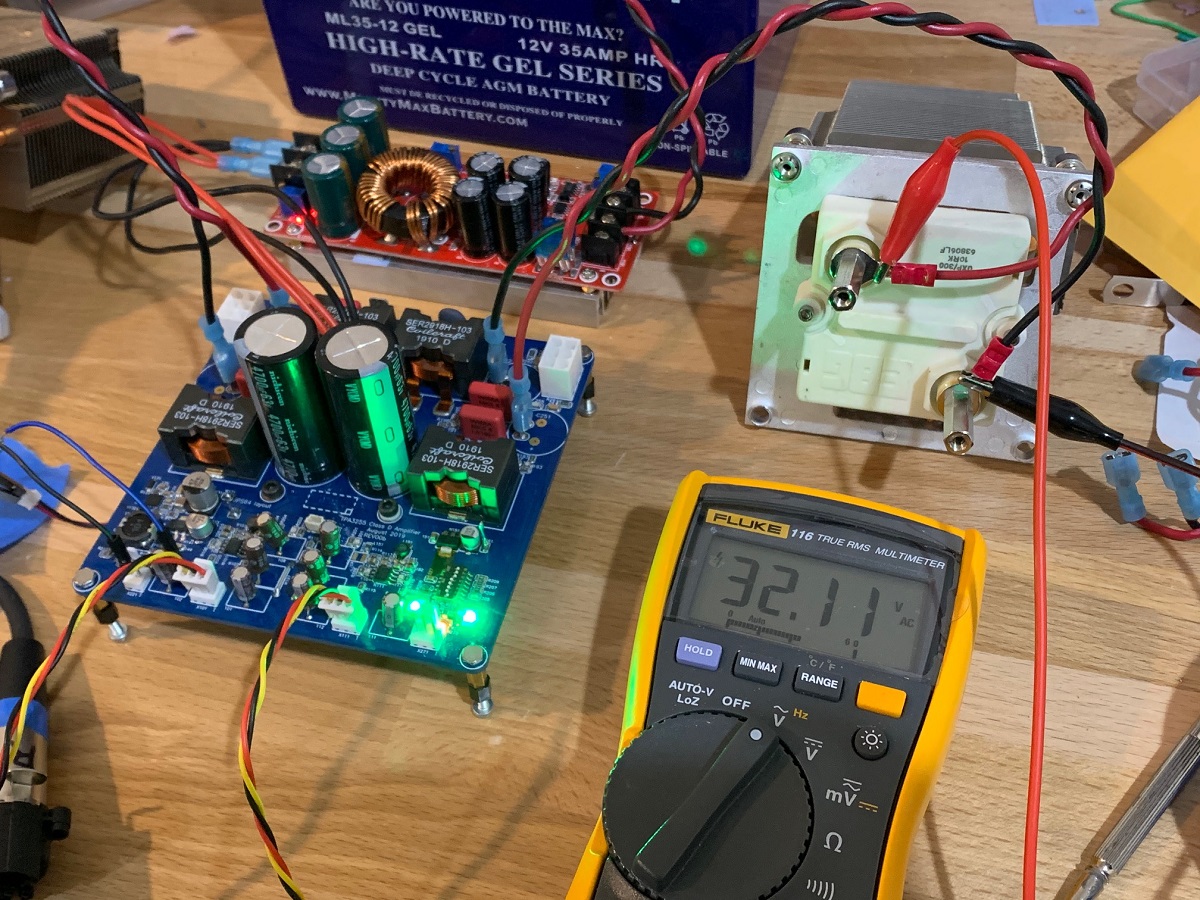
32.1Vrms x 2.832 = 90.9Vpp This value is about 103w into 10ohms.
Here is the overall setup on my bench:
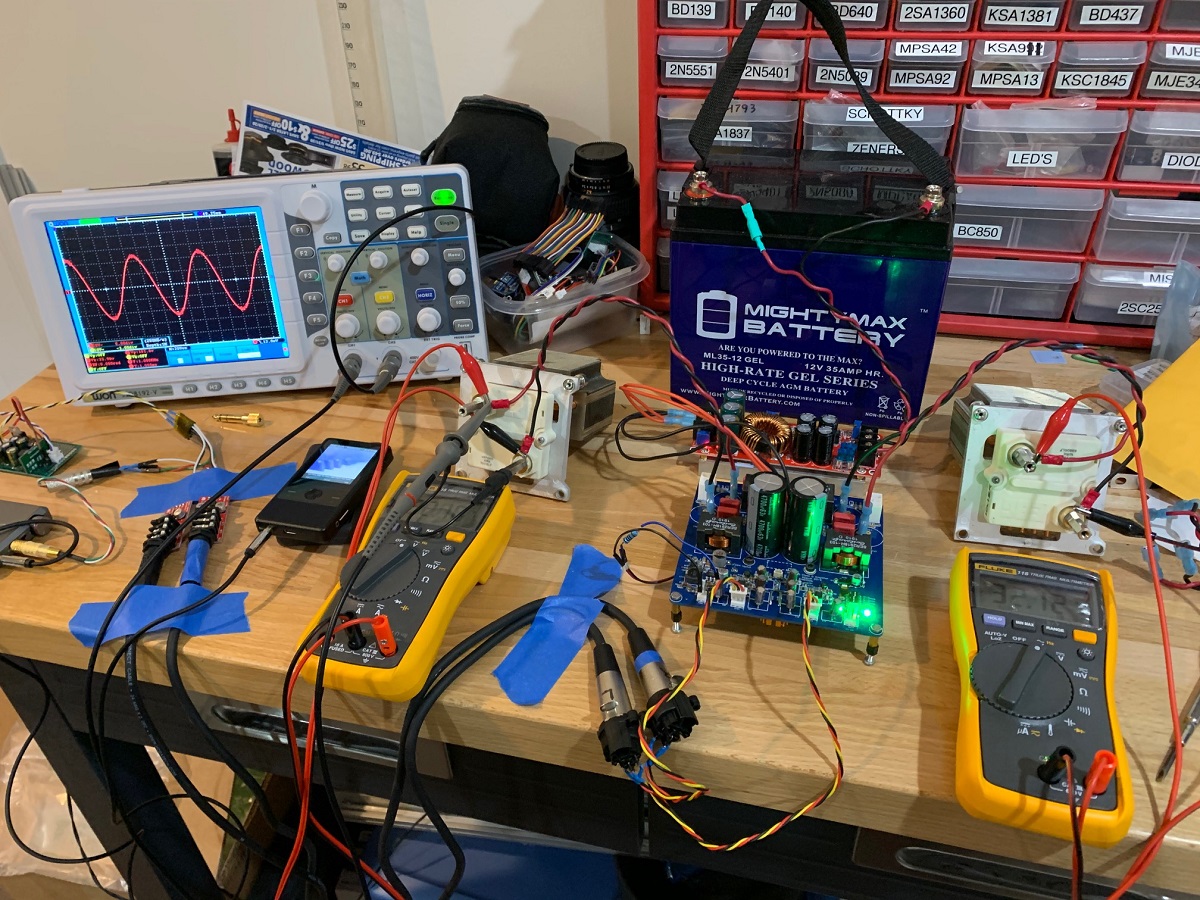
Here is a screenshot of the O-scope, vertical scale is 20Vac:
We can see clearly, that the peak-to-peak relative to the two output terminals of the BTL amp produces more than the +51Vdc of the PSU. The scope analysis window says it is 103Vpp (probably accounting for the distortion hash at the peaks).
Here is a closeup of the DVM and amp:
32.1Vrms x 2.832 = 90.9Vpp This value is about 103w into 10ohms.
Here is the overall setup on my bench:
Attachments
Last edited:
- Home
- Amplifiers
- Class D
- TPA3255 - all about DIY, Discussion, Design etc
